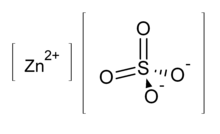 Chemical model | |
| Clinical data | |
|---|---|
| Pronunciation | zink SUL fate |
| Trade names | Solvazinc, Micro-Zn, others |
| AHFS/Drugs.com | Professional Drug Facts |
| License data |
|
| Routes of administration | By mouth, intravenous |
| Legal status | |
| Legal status |
|
| Identifiers | |
| |
| Chemical and physical data | |
| Formula | O4SZn |
| Molar mass | 161.47 g·mol−1 |
| 3D model (JSmol) | |
| |
| |
Zinc sulfate is used medically as a dietary supplement.[3] Specifically it is used to treat zinc deficiency and to prevention the conditions in those at high risk.[3] This includes use together with oral rehydration therapy for children who have diarrhea.[4] General use is not recommended.[3] It may be taken by mouth or by injection into a vein.[3]
Side effects may include abdominal pain, vomiting, headache, and feeling tired.[4] While normal doses are deemed safe in pregnancy and breastfeeding, the safety of larger doses is unclear.[1] Greater care should be taken in those with kidney problems.[4] Zinc is an essential mineral in people as well as other animals.[5]
The medical use of zinc sulfate began as early as the 1600s.[6] It is on the World Health Organization's List of Essential Medicines.[7] Zinc sulfate is available as a generic medication and over the counter.[3][1] The wholesale cost in the developing world is about US$0.01–18 per day.[8] In the United Kingdom ten days of treatment costs the NHS about 4.32 pounds.[3]
References edit
- ^ a b c "Zinc sulfate Use During Pregnancy". Drugs.com. 9 December 2019. Archived from the original on 16 September 2016. Retrieved 8 June 2020.
- ^ "WHOCC - ATC/DDD Index". www.whocc.no. Archived from the original on 29 October 2020. Retrieved 12 September 2020.
- ^ a b c d e f British national formulary : BNF 69 (69 ed.). British Medical Association. 2015. p. 700. ISBN 9780857111562.
- ^ a b c World Health Organization (2009). Stuart MC, Kouimtzi M, Hill SR (eds.). WHO Model Formulary 2008. World Health Organization. pp. 349–51. hdl:10665/44053. ISBN 9789241547659.
- ^ Council, National Research; Studies, Division on Earth and Life; Resources, Board on Agriculture and Natural; Animals, Committee on Minerals and Toxic Substances in Diets and Water for (2006). Mineral Tolerance of Animals: Second Revised Edition, 2005. National Academies Press. p. 420. ISBN 9780309096546. Archived from the original on 2017-01-16.
- ^ Sneader, Walter (2005). Drug Discovery: A History. John Wiley & Sons. p. 62. ISBN 9780471899792. Archived from the original on 2017-01-16.
- ^ World Health Organization (2019). World Health Organization model list of essential medicines: 21st list 2019. Geneva: World Health Organization. hdl:10665/325771. WHO/MVP/EMP/IAU/2019.06. License: CC BY-NC-SA 3.0 IGO.
- ^ "Zinc Sulfate". International Drug Price Indicator Guide. Archived from the original on 22 January 2018. Retrieved 8 December 2016.